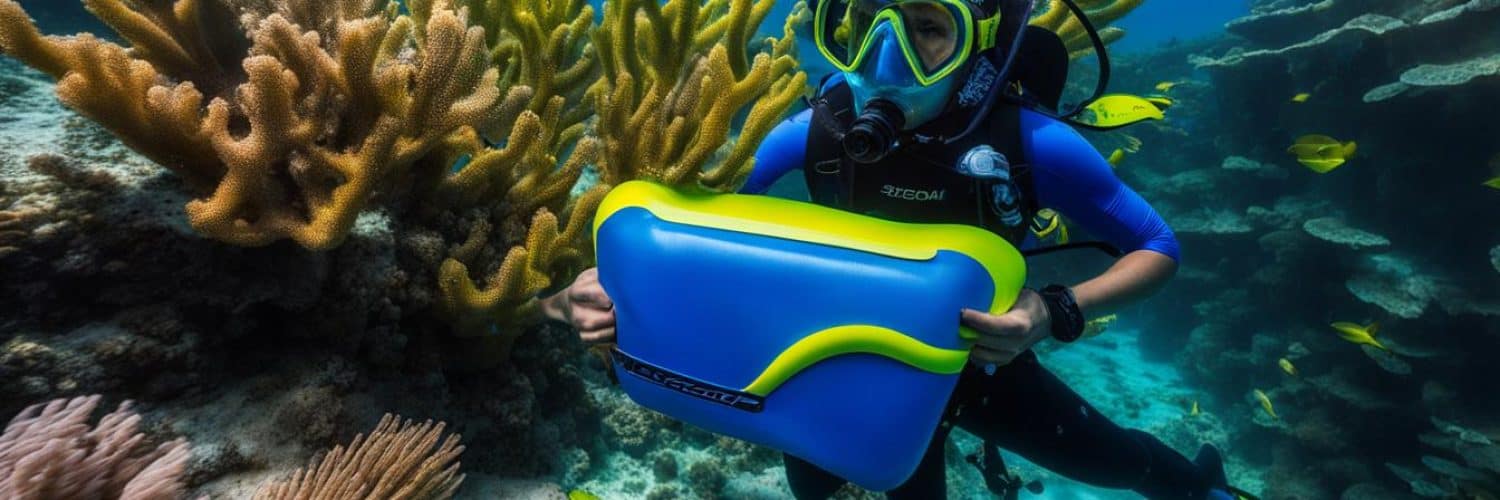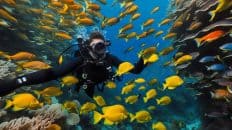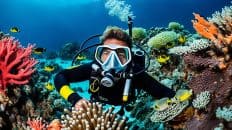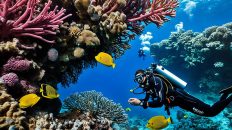Scuba diving offers a breathtaking and immersive experience in the underwater world. To fully enjoy this adventure, it is essential to have the right scuba snorkel gear. Whether you are a beginner or a seasoned diver, understanding and choosing the right equipment is crucial for your safety, comfort, and enjoyment.
In this comprehensive dive gear guide, we will explore the essential equipment required for scuba diving. From masks and snorkels to dive computers and exposure protection suits, each gear component plays a vital role in enhancing your diving skills and ensuring a memorable underwater excursion.
Key Takeaways:
- Choosing the right scuba snorkel gear is essential for a safe and enjoyable diving experience.
- Understanding the purpose and function of each gear component is crucial for beginners and experienced divers alike.
- Proper fit and functionality of gear are essential for optimal performance underwater.
- Scuba snorkel gear includes masks, snorkels, fins, exposure protection suits, dive computers, regulators, BCDs, weights, and accessories.
- Exploring scuba snorkel destinations and enrolling in scuba snorkel courses can further enhance your skills and knowledge.
Understanding Scuba Diving Equipment: A Basic Guide for Beginners
Scuba diving equipment is a combination of essential gear that allows divers to explore the underwater world. Understanding the names and purposes of each scuba gear component is important for both beginners and experienced divers. Key equipment includes the mask, snorkel, fins, exposure protection suits (wetsuit or drysuit), scuba tank, Buoyancy Control Device (BCD), regulator, submersible pressure gauge (SPG), and dive computer. Other equipment such as weights and accessories like compass, dive light, and cutting tool also enhance the diving experience.
Let’s take a closer look at some of the important scuba gear components:
1. Mask
The mask is an essential piece of scuba diving equipment that provides a clear view underwater by creating an air pocket in front of the diver’s eyes. It helps to protect the eyes from water and ensures comfortable breathing through the nose. A well-fitting mask with a good seal is important for preventing water leakage.
2. Snorkel
A snorkel is a tube that allows divers to breathe at the surface without having to lift their head out of the water. It enables continuous breathing while observing the underwater environment. Choosing a snorkel with features like a comfortable mouthpiece and effective purge valve enhances the diving experience.
3. Fins
Fins are used for propulsion and maneuvering in the water. They enhance a diver’s speed, agility, and efficiency underwater. Fins come in various styles, including open-heel and full-foot fins. Selecting the right size and style of fins ensures comfort and maximum performance.
4. Exposure Protection Suits
Exposure protection suits, such as wetsuits and drysuits, are worn to maintain body temperature in different water conditions. Wetsuits are made of foamed neoprene, providing insulation by trapping a thin layer of water between the suit and the diver’s body. Drysuits are waterproof suits that keep divers completely dry by sealing out water.
5. Scuba Tank
The scuba tank or cylinder holds the compressed air that divers breathe underwater. It is usually made of metal and comes in different sizes and capacities. Proper tank maintenance and regular inspections are crucial for diver safety.
6. Buoyancy Control Device (BCD)
The BCD is a vest-like device that allows divers to control their buoyancy underwater. It can be inflated or deflated to adjust the diver’s position in the water. The BCD also serves as a harness for attaching other gear and accessories.
7. Regulator
The regulator is a device that delivers the air from the scuba tank to the diver at the appropriate pressure for breathing. It consists of a first stage, which attaches to the tank, and a primary and alternate second stage, which are used for breathing. The regulator ensures a steady and consistent airflow for comfortable diving.
8. Submersible Pressure Gauge (SPG)
The SPG, also known as a pressure gauge, provides divers with real-time information about the amount of air remaining in the scuba tank. It helps divers manage their air consumption and avoid running out of air underwater.
9. Dive Computer
A dive computer is an electronic device that provides essential information about depth, dive time, decompression limits, and ascent rates. It helps divers plan and execute safe dives by tracking and displaying important data. Some dive computers also have additional features like air integration and compass.
10. Weights
Dive weights are used to counteract the buoyancy of the diver and equipment. They help to achieve neutral buoyancy at different depths and maintain proper trim underwater. Correct weighting contributes to comfort, stability, and control during the dive.
Exploring the underwater world with the right scuba diving equipment is an incredible and rewarding experience. Each gear component plays a vital role in ensuring comfort, safety, and enjoyment during dives. By understanding the purpose and proper use of scuba gear, beginners can dive confidently and experienced divers can enhance their skills.
Choosing the Right Mask, Snorkel, and Fins for Scuba Diving
When it comes to scuba diving gear, the mask, snorkel, and fins are essential components that can greatly enhance your underwater experience. Each of these pieces of equipment plays a critical role in facilitating comfort, safety, and efficiency during your dives.
The Perfect Fit: Mask Fitting
A well-fitting scuba diving mask is crucial for a watertight seal, ensuring clear vision and preventing leaks. To find the right mask:
- Hold the mask against your face without using the strap, ensuring it covers your nose and extends to your temples.
- Inhale gently through your nose to create a suction effect, checking if the mask stays in place without feeling uncomfortable or leaving any gaps.
- Test the mask for leaks by pressing gently against your face and inhaling. If the mask remains sealed and adheres to your face, it’s a good fit.
- Consider opting for a mask with adjustable straps and a skirt made of soft, hypoallergenic silicone for maximum comfort.
Snorkel Features: Comfort and Breathing Efficiency
Choosing the right snorkel involves finding the perfect balance between dry comfort and breathing efficiency. Look for the following features:
- A comfortable mouthpiece made of soft, hypoallergenic silicone to reduce jaw fatigue.
- A purge valve to easily clear any water that enters the snorkel.
- A dry-top design that prevents water from entering the snorkel while on the surface.
- A flexible and ergonomic shape that ensures a comfortable fit against your face.
Fins: Comfort and Efficient Movement
Fins are essential for efficient movement and propulsion through the water. Here are some considerations when choosing fins:
- Fit: Fins should be snug but not too tight, providing a comfortable fit that prevents slipping without causing discomfort.
- Types: Full-foot fins are designed to be worn barefoot while open-heel fins require dive boots. Consider the type that suits your preferences and diving conditions.
- Blade Length and Rigidity: Longer blades offer more power, while shorter blades are great for maneuverability. Find the right balance for your diving style.
- Materials: Look for fins made of lightweight materials like composite plastics or carbon fiber for optimal performance.
Comparison of Scuba Diving Fins
| Fin Model | Blade Type | Blade Length | Rigidity | Features |
|---|---|---|---|---|
| Cressi Rondinella | Full-foot | Medium | Flexible | Quick-release buckles, ergonomic foot pocket |
| Mares Avanti Quattro+ | Open-heel | Long | Medium | Channel thrust technology, bungee strap system |
| Scubapro Jet Fins | Open-heel | Short | Rigid | Vented blade design, adjustable strap |
Remember, choosing the right mask, snorkel, and fins is essential for a comfortable and efficient scuba diving experience. Take the time to find gear that fits properly and meets your specific needs. With the right equipment, you’ll enjoy exploring the wonders of the underwater world to the fullest.
The Importance of Exposure Protection: Wetsuits and Drysuits
When it comes to scuba diving, exposure protection is key to staying warm and comfortable underwater. Two popular options for divers are wetsuits and drysuits. Understanding their differences and choosing the right one for your needs is essential for a successful dive.
Wetsuits:
Wetsuits are typically made of foam neoprene rubber, which provides both insulation and buoyancy. The neoprene material traps a thin layer of water between the suit and the skin, which is warmed by body heat to keep the diver warm. This layer of water also helps to regulate body temperature during the dive.
Wetsuits come in a variety of thicknesses, ranging from 2mm to 7mm, with the thicker suits offering more insulation for colder waters. The choice of wetsuit thickness depends on the water temperature you will be diving in. For example, a 3mm wetsuit is suitable for warm waters, while a 7mm wetsuit is recommended for colder temperatures.
Drysuits:
Drysuits, on the other hand, are designed to keep divers completely dry by preventing water from entering the suit. They are typically made of a waterproof material with built-in boots and seals at the wrists and neck. Unlike wetsuits, drysuits do not rely on body heat to keep divers warm.
Divers wear insulation under the drysuit, such as thermal undergarments, to provide warmth. This insulation allows divers to layer up depending on the water temperature and personal comfort. Drysuits are a suitable choice for diving in extremely cold waters or prolonged exposure to low temperatures.
Choosing the right exposure protection suit depends on various factors, including water temperature, duration of the dive, and personal preference. Both wetsuits and drysuits have their advantages and are designed to meet the specific needs of divers in different environments.
Investing in quality exposure protection gear ensures not only comfort but also safety during your dives. It is important to keep in mind that wetsuits and drysuits come in different sizes and styles, so it’s crucial to find a suit that fits you properly and allows for a full range of motion underwater.
Now that we have explored exposure protection, let’s move on to the next section to discover the importance of dive computers in ensuring a safe and efficient diving experience.
Comparison of Wetsuits and Drysuits
| Feature | Wetsuits | Drysuits |
|---|---|---|
| Material | Foam neoprene rubber | Waterproof material |
| Insulation | Relies on body heat and a thin layer of water | Requires thermal undergarments |
| Waterproof | No | Yes |
| Buoyancy | Provides buoyancy | Requires additional buoyancy control |
| Temperature Range | 2mm to 7mm (depending on water temperature) | Variable, as insulation can be adjusted |
| Fit | Tighter fit | Looser fit |
Dive Computers: Your Underwater Safety Companion
Dive computers are essential tools for every scuba diver. These compact devices provide critical information that ensures a safe and enjoyable diving experience. Let’s take a closer look at the features and benefits of dive computers.
Monitor Your Dive with Precision
Dive computers allow you to track important diving parameters such as depth, dive time, and remaining air supply. With precise and real-time data at your fingertips, you can make informed decisions underwater and optimize your dive plan. Say goodbye to time-consuming and error-prone dive tables!
Dive Planning Made Easy
Planning your dives becomes a breeze with the dive planning tools integrated into dive computers. These tools assist divers in creating safe and efficient dive profiles by considering factors such as nitrogen absorption, ascent rate limits, and decompression stops. Whether you’re a beginner or an experienced diver, dive computers help you plan memorable and worry-free dives.
Enriched Air Compatibility
Advanced dive computers have the capability to support enriched air, also known as nitrox. This feature allows you to extend your bottom time and shorten surface intervals by breathing a gas mixture with a higher oxygen content. With enriched air compatibility, you can maximize your dive time and explore the underwater world for longer.
Temperature Display
Stay aware of the water temperature with the temperature display feature on dive computers. This information is vital for divers as it affects thermal comfort and the choice of exposure protection. By keeping track of the water temperature, you can ensure a comfortable and enjoyable dive.
Integrated Air Monitoring
Knowing how much air you have left is crucial for safe diving. Dive computers with integrated air monitoring allow you to keep a close eye on your remaining air supply without the need for additional gauges. This eliminates the guesswork and ensures you’re always aware of your air consumption.
“Dive computers are like having a dive buddy on your wrist. They provide essential information and safety features that enhance your diving experience.”
– Sarah Thompson, Advanced Open Water Diver
Investing in your own dive computer is a wise choice for any serious scuba diver. Not only does it offer convenience and personalized features, but it also enhances your safety underwater. With dive computers, you can dive with confidence and make the most out of your underwater adventures.
The Importance of Regulators in Scuba Diving
Scuba diving regulators are an essential piece of equipment that allows divers to breathe underwater. They play a vital role in converting high-pressure air from the tank into breathable pressure, ensuring a safe and enjoyable diving experience.
The regulator consists of three main components: the first stage, primary second stage, and alternate second stage.
The first stage connects the regulator to the cylinder valve and controls the flow of air. It reduces the high-pressure air from the tank to an intermediate pressure, which is then delivered to the second stages.
The primary second stage is the part that divers put in their mouth to breathe. It delivers the air at a pressure that is comfortable for inhalation and provides a smooth and consistent airflow. It is the primary source of breathing while diving.
The alternate second stage serves as a backup air source for emergencies. It is typically attached to a longer hose and can be shared with another diver in need of air. Having an alternate second stage adds an extra layer of safety during dives.
Without regulators, divers would not be able to breathe underwater, making them a crucial component of scuba diving gear. Regulators ensure a continuous supply of air at the right pressure, allowing divers to explore the underwater world with confidence and peace of mind.
Here is a table summarizing the key components and functions of scuba diving regulators:
| Component | Function |
|---|---|
| First Stage | Connects the regulator to the cylinder valve and reduces high-pressure air to an intermediate pressure. |
| Primary Second Stage | Delivers air at a comfortable pressure for inhalation and provides a smooth airflow for breathing. |
| Alternate Second Stage | Serves as a backup air source for emergencies and can be shared with another diver in need. |
“The regulator ensures a continuous supply of breathable air, allowing divers to explore the underwater world with confidence and peace of mind.”
The Role of BCDs in Buoyancy Control and Dive Gear Management
Buoyancy Control Devices (BCDs) are essential equipment for scuba divers, playing a crucial role in managing underwater buoyancy. They enable divers to achieve neutral buoyancy at any depth, allowing for effortless movement and precise control in the water.
One important aspect of BCDs is finding the right fit. Proper BCD fitting ensures comfort and safety during dives. It is crucial to consider factors such as body size, shape, and personal preferences when selecting a BCD. A well-fitted BCD allows for maximum mobility and helps prevent discomfort or strain while underwater.
BCDs not only provide buoyancy control, but they also serve as a secure attachment point for other dive gear. They offer various attachment options for accessories such as compasses, dive lights, and cutting tools. These features allow divers to customize their BCDs based on their specific diving needs and preferences.
BCDs offer different styles and features to cater to divers’ individual requirements. Some divers prefer jacket-style BCDs, which provide a balanced lift across the torso. Others opt for back-inflated BCDs that offer a streamlined profile and better range of motion. Choosing the right BCD style and features enhances comfort and functionality during dives.
BCDs allow divers to achieve buoyancy control through inflation and deflation. By adding air to the BCD, divers increase buoyancy, while venting air from the BCD reduces buoyancy. It is important to have an easy-to-reach inflator hose and user-friendly controls for hassle-free operation. Being able to fine-tune buoyancy levels enables divers to maintain stability and control throughout their dive.
In conclusion, BCDs are indispensable tools for scuba divers, offering buoyancy control and gear management capabilities. With the right BCD fit, divers can enjoy a comfortable and secure diving experience. The attachment options and features provided by BCDs further enhance convenience and customization. Understanding and utilizing BCD inflation and deflation techniques ensure optimal buoyancy control, enabling divers to explore the underwater world with ease.
Dive Weights: Enhancing Diving Efficiency and Trim
Dive weights are an essential component of scuba diving gear, playing a crucial role in achieving proper buoyancy and trim underwater. Proper weighting ensures that divers can descend and ascend easily while maintaining neutral buoyancy, allowing for better control and comfort in the water.
When it comes to dive weights, divers have two primary options to choose from: weight belts and integrated weight systems. The choice between the two depends on personal preference and equipment setup. Weight belts are a traditional and versatile option, allowing divers to easily add or remove weights as needed. On the other hand, integrated weight systems offer a streamlined approach by incorporating the weights into the BCD or weight pockets, reducing the need for a separate belt.
Correct weighting is essential for achieving optimal buoyancy and trim. Divers should consider factors such as their body composition, exposure protection, and equipment configuration when determining the appropriate amount of weight to use. It is recommended to start with a conservative weight and make adjustments based on individual needs and conditions.
Furthermore, choosing the right weighting system contributes to better diving efficiency and comfort. By distributing the weights correctly, divers can maintain a horizontal trim and minimize excess effort while swimming. This improves overall dive performance and conserves energy, allowing for longer and more enjoyable dives.
Benefits of Proper Weighting:
- Enhanced buoyancy control and stability
- Improved body positioning for optimal trim
- Reduced exertion and fatigue
- Increased underwater maneuverability
Proper weighting is crucial for divers to achieve the ideal balance of buoyancy, trim, and control. It ensures a more enjoyable and efficient diving experience, allowing divers to focus on exploring the wonders of the underwater world.
Weighting System Comparison:
| Weighting System | Pros | Cons |
|---|---|---|
| Weight Belt | – Versatile and adjustable – Easy to add or remove weights – Can be used with different exposure protection |
– May require readjustment during the dive – Potential discomfort if not fitted properly – Additional equipment to manage |
| Integrated Weight System | – Streamlined and integrated with BCD or weight pockets – Reduces the need for a separate weight belt – Enhanced stability and ease of use |
– Limited adjustability during the dive – Restricted to specific BCD models – May require additional cost |
Choosing the right weighting option is a personal decision. It’s important to consider factors such as comfort, ease of use, and individual diving needs when selecting a system that best fits your preferences.
Conclusion
Scuba diving is an exhilarating and awe-inspiring activity that allows individuals to explore the wonders of the underwater world. To ensure a safe and enjoyable diving experience, it is essential to have the right scuba diving gear. Each piece of equipment, from masks and snorkels to fins and exposure protection suits, plays a crucial role in enhancing comfort, safety, and efficiency underwater.
Choosing the right gear is of utmost importance, regardless of your diving experience level. A comprehensive scuba diving gear guide can help you navigate the diverse options available in the market. By selecting gear that fits well and offers optimal functionality, you can maximize the benefits of your scuba snorkel adventures.
Remember, the right scuba diving equipment is more than just a collection of items. It is your lifeline underwater, allowing you to breathe comfortably, move effortlessly, and monitor essential diving information. Prioritize gear fit and functionality when making your choices, and always invest in high-quality brands and products. By doing so, you can dive with confidence and fully immerse yourself in the beauty and tranquility of the underwater realm.
FAQ
What are the essential components of scuba diving equipment?
The essential components of scuba diving equipment include a mask, snorkel, fins, exposure protection suits, scuba tank, Buoyancy Control Device (BCD), regulator, submersible pressure gauge (SPG), and dive computer.
How do I choose the right mask, snorkel, and fins for scuba diving?
When choosing a mask, ensure a good watertight fit. Consider comfort and ease of breathing when selecting a snorkel. Fins should provide comfort, a snug fit, and efficient movement through the water.
What is the purpose of exposure protection suits in scuba diving?
Exposure protection suits, such as wetsuits and drysuits, keep divers warm and comfortable underwater. Wetsuits provide thermal insulation, while drysuits offer waterproof construction to keep divers dry.
Why are dive computers important in scuba diving?
Dive computers monitor critical information such as depth, dive time, and remaining air supply. They also offer additional features such as dive planning tools, enriched air compatibility, temperature display, and integrated air monitoring.
What is the role of regulators in scuba diving?
Regulators allow divers to breathe underwater by converting high-pressure air from the tank to breathable pressure. The first stage attaches the primary and alternate second stages to the cylinder valve. The primary second stage is used for regular breathing, while the alternate second stage serves as a backup air source.
What is the purpose of Buoyancy Control Devices (BCDs) in scuba diving?
BCDs help divers manage underwater buoyancy, allowing them to achieve neutral buoyancy at any depth. They also hold gear in place and provide attachment options for accessories such as compasses, dive lights, and cutting tools.
How do dive weights enhance diving efficiency and trim?
Dive weights ensure proper buoyancy and trim underwater. Divers can choose between a weight belt or an integrated weight system. Proper weighting allows easy descent and ascent while maintaining neutral buoyancy.
What is the importance of choosing the right scuba gear?
Choosing the right scuba gear is vital for a safe and enjoyable diving experience. Proper gear fit and functionality enhance performance and maximize the benefits of scuba snorkel adventures.







Add comment